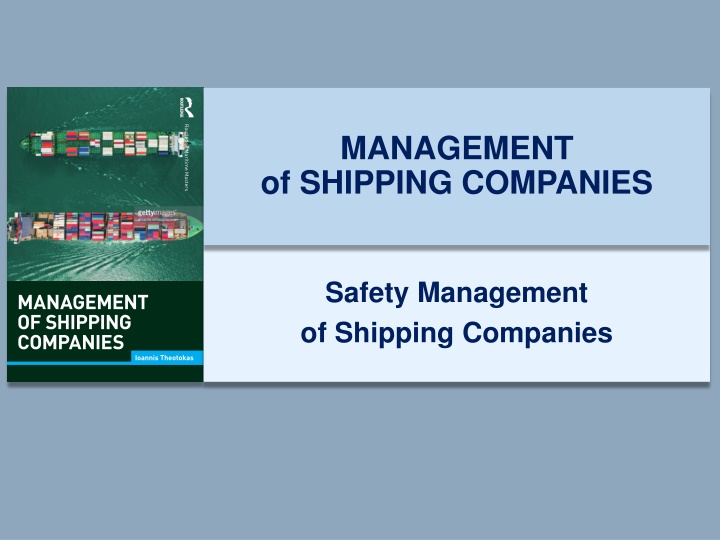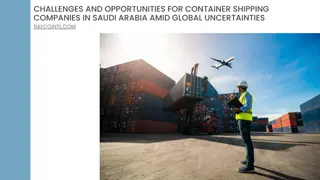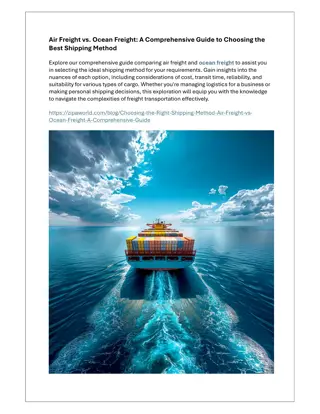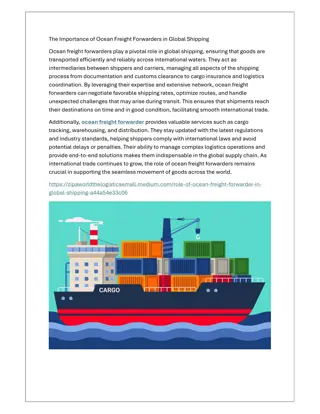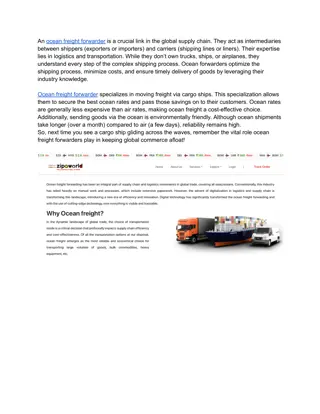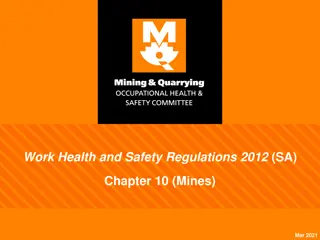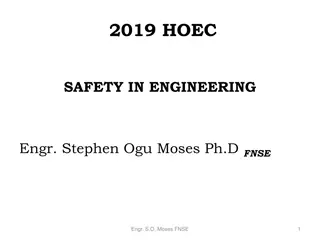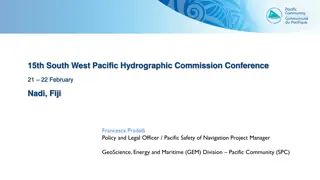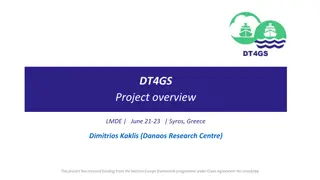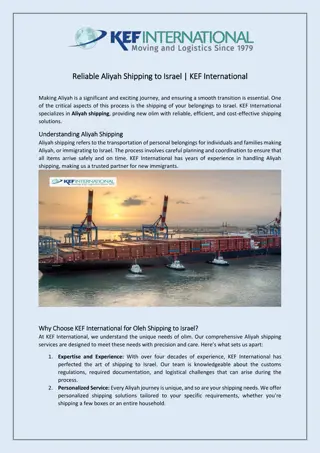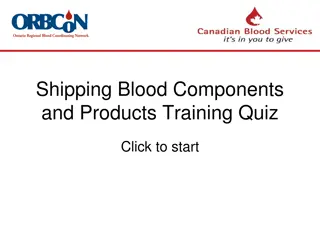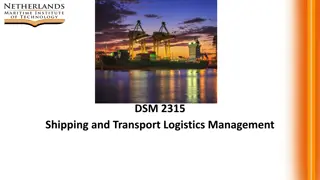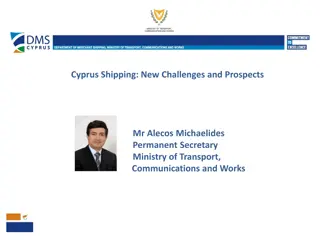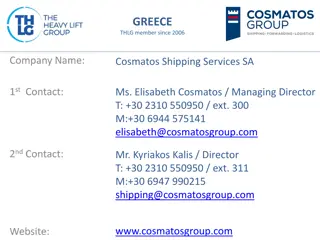Safety Management in Shipping Companies: Regulations and Challenges
Over the last decades, shipping management has seen the implementation of various regulations and standards to ensure the security of human life, protection of the marine environment, and compliance with safety measures. The focus has shifted towards self-regulation by shipping companies, emphasizing safety at sea, prevention of accidents, and environmental protection. However, challenges exist in balancing regulations with profit motives and transitioning to total safety responsibility within the shipping industry.
Download Presentation

Please find below an Image/Link to download the presentation.
The content on the website is provided AS IS for your information and personal use only. It may not be sold, licensed, or shared on other websites without obtaining consent from the author.If you encounter any issues during the download, it is possible that the publisher has removed the file from their server.
You are allowed to download the files provided on this website for personal or commercial use, subject to the condition that they are used lawfully. All files are the property of their respective owners.
The content on the website is provided AS IS for your information and personal use only. It may not be sold, licensed, or shared on other websites without obtaining consent from the author.
E N D
Presentation Transcript
MANAGEMENT of SHIPPING COMPANIES Safety Management of Shipping Companies
The context Over the last decades, a number of regulations (ISM Code, STCW, ILO conventions) or standards(ISO 9001, ISO 14001, OHSAS) entered into force. Target: Security of human life and property Protection of the marine environment Reasoning: Shipping management is largely standardized. Procedures and controls may be in place to ensure that the services produced meet the standards Quality in shipping is not only dependent on the shipping companies. 2 Safety Management of Shipping Companies I. Theotokas (2018) Management of Shipping Companies London: Routledge
the context ... Maritime transportation is one of the links in the transportation chain Concentration on prevention in only one link in the chain is of limited effectiveness Safety and quality is not simply a matter of regulations Every new regulation can be considered as an opportunity for those players who do not seek for compliance but instead for instant profits The flag of convenience sector as an example 3 Safety Management of Shipping Companies I. Theotokas (2018) Management of Shipping Companies London: Routledge
the context The rate of increase in accidents at sea gives rise to a need for regulation by the introduction of new rules However, competition prompts many maritime actors to put profit before safety, which imposes limitations on or invalidates the regulation process The move from regulator responsibility to companies taking total safety responsibility has not yet taken place in the shipping industry (Storkersen et al, 2016). The transition from regulation to self-regulation presupposes support from administrative bodies and co-operation between companies. Container Ship Safety Forum Shell annual safety workshops 4 Safety Management of Shipping Companies I. Theotokas (2018) Management of Shipping Companies London: Routledge
The ISM Code Focuses on the implementation of standards and procedures by shipping companies, Basic aims to ensure safety at sea, prevention of human injury or loss of life, and avoidance of damage to the environment, in particular to the marine environment, and to property . Emphasis on prevention Standardisation 5 Safety Management of Shipping Companies I. Theotokas (2018) Management of Shipping Companies London: Routledge
ISM Code units Definitions, objectives, application and functional requirements for a SMS 1 Safety and environmental protection policy 2 Company responsibility and authority 3 Designated Person(s) 4 Master s responsibility and authority 5 Resources and personnel 6 Shipboard operations 7 Emergency preparedness 8 Reports and analysis of non-conformities, accidents and hazardous occurrences 9 Maintenance of the ship and equipment 10 Documentation 11 Company verification, review and evaluation 12 6 Safety Management of Shipping Companies I. Theotokas (2018) Management of Shipping Companies London: Routledge
Safety Management System (SMS) Each shipping company must set up, implement, and maintain a Safety Management System/SMS The SMS contains a series of functional requirements, directives, and procedures in connection with A? safety? and? environmental?protection?policy Instructions and procedures to ensure safe operation?of? ships? and? protection?of? the? environment?in? compliance? with?relevant? international?and? flag? State? legislation? Defined levels of authority andlines ofcommunication between, andamongst, shore? and? shipboard?personnel? Procedures for reporting accidents and non-conformities with the provisions ofthis? Code Procedures to prepare for andrespond to emergency situations? Procedures for internal audits and managementreviews Development and implementation of SMS lead to Document of compliance for the company Safety Management Certificate for the ship 7 Safety Management of Shipping Companies I. Theotokas (2018) Management of Shipping Companies London: Routledge
The aspects of ISM Code the management The management is responsible for the development, implementation, and maintenance of an effective system of safety management on land and on board the ships which will put into practice the company's policy. The system includes accessible to all procedures, plans, directives description of the responsibilities and authority of each individual in connection with the policy on safety and the protection of the marine environment, he definition of the Designated Person Ashore (DPA) Designated Person Ashore: the person who has direct access to the highest level of management, designated to ensure the safe operation of each ship and to provide a link between the company and the people on board. 8 Safety Management of Shipping Companies I. Theotokas (2018) Management of Shipping Companies London: Routledge
The aspects of ISM Code - People People: the key for the system s effectiveness The SMS places emphasis on the qualifications which the personnel must possess in order to respond to the requirements of the SMS. It requires from the company to ensure that the captain has the qualifications to manage, each ship is manned with qualified and healthy seafarers in accordance with international standards. Emphasis on communication between the members of the crew, on ensuring that orders are conveyed to those involved in a suitable way. Procedures for the familiarisation of new personnel with their duties, the understanding by the whole of the personnel involved in the implementation of the SMS of the rules, regulations, and directives, the recognition of the training needs of the personnel and the provision of the relevant training, the provision of information to the seafarers in connection with their job in language which is intelligible to them. 9 Safety Management of Shipping Companies I. Theotokas (2018) Management of Shipping Companies London: Routledge
The aspects of ISM Code Ship & equipment The ship is the working environment for seafarers. The company must design procedures to ensure the maintenance of the vessel in accordance with the regulations and specifications which it lays down itself, that inspections are carried out at appropriate times, non-conformities are recorded and their causes given, corrective action is taken, entries are kept for each relevant action. The company must define the equipment and systems whose operation is crucial for the ship, the measures which it takes to ensure the reliability of these systems. 10 Safety Management of Shipping Companies I. Theotokas (2018) Management of Shipping Companies London: Routledge
The aspects of ISM Code - procedures Procedures : means for the transmission of experience. They are enhanced by acquired experience and contribute to the avoidance of the repetition of errors (Chauvel, 1997). The term procedures is to be found in almost all the units of the ISM. The company must develop procedures to ensure the safe operation of ship and protection of the environment, the familiarisation of new personnel, the training of the personnel, the crucial processes on board ship, the response to emergency shipboard situations, the reporting of non-conformities, accidents, and hazardous situations and the relevant corrective actions, internal audits and management reviews, the maintenance of the vessel, the checking of the documents and data relating to the SMS, the periodical assessment of the SMS, the required verifications. 11 Safety Management of Shipping Companies I. Theotokas (2018) Management of Shipping Companies London: Routledge
Tanker Management Self Assessment (I) The OCIMF applied the TMSA programme (2004): As a guide to good practices in the management of ships The TMSA adopts approaches which concern standards as regards safety, quality, the environment, health, and safety at work. It has been revised twice - in 2008 and 2017. It encourages companies to estimate and assess the level of safety of their systems in relation to the predetermined ey erformance Indicators/ s Each manager carries out his own internal assessment in the light of more than 260 performance indicators in 13 areas of operation and grades performance and progress in each area 12 Safety Management of Shipping Companies I. Theotokas (2018) Management of Shipping Companies London: Routledge
Tanker Management Self Assessment (II) It is based on the principles of the ISM Code Encourages managers of tankers to check the procedures which relate to safety, quality, and the protection of the environment It introduces four levels of assessment A company which fully implements the letter and spirit of the of the ISM Code should be able to self-assess itself at Level 1. The aim of the TMSA is to encourage the companies to seek continuous improvement, Even if a company is at Level 4, it should not cease to seek the means of further improvement of its processes. It provides companies with the performance indicators, but not with the way in which performance will be measured. It contributes to employees awareness of the processes crucial for their performance, it permits assessment of the risk which may arise in these areas, It contributes to a safety culture and to efforts to achieve continuous improvement of the systems It favours the improvement of the knowledge and skills of the personnel by means of planned training, and permits the company to be informed of its performance, and to compare this with that of its competitors It contributes to the recording, dissemination, and enhancement of the knowledge 13 Safety Management of Shipping Companies I. Theotokas (2018) Management of Shipping Companies London: Routledge
Elements of TMSA 14 Safety Management of Shipping Companies I. Theotokas (2018) Management of Shipping Companies London: Routledge
Management of SQEH&E. The integrated approach The improvement of safety is more completely achieved when, in parallel, objectives are attained which have a connection with the quality of the services, the management of the environment, health, and safety at work, energy performance. Compatibility and advantages of the joint development of safety and quality systems in the effective operation of shipping companies The development of management systems on the basis of optional standards relating to quality, the environment, health and safety, and energy performance is a widespread practice among companies ISO 9001, ISO 14001, ISO 50001 and OHSAS 18001 standards have wider application than ISM Code Classification societies advise the development by shipping companies of integrated management systems Combined procedures ease implementation and reduce conflicting information and documents which are given to crew members, give good guidance to them, and prove compliance to the highest degree 15 Safety Management of Shipping Companies I. Theotokas (2018) Management of Shipping Companies London: Routledge
ISO Standards The standards ISO 9001, ISO 14001, ISO 5001 and OHSAS 18001 are based on the management principles of continuous improvement, i.e., the Plan-Do-Check- Act (PDCA) cycle. These four items correspond to the steps in the Shewhart/Deming cycle, which is orientated towards continuous improvement. 'Plan' involves the defining of the problem, its analysis, and the taking of corrective measures; Do' is concerned with the implementation of the proposal for improvement by the solving of the problem; 'Check' involves confirmation that the results are satisfactory, 'Act' is about securing the benefit derived from the improvement and standardisation of the procedures 16 Safety Management of Shipping Companies I. Theotokas (2018) Management of Shipping Companies London: Routledge
ISO 9001:2015 Quality Management Sets out the requirement for a quality management system. It is based on quality management principles of customer focus, leadership, engagement of people, process approach, improvement, evidence-based decision- making and relationship management, and helps businesses and organisations to be more efficient 17 Safety Management of Shipping Companies I. Theotokas (2018) Management of Shipping Companies London: Routledge
ISO 14001 Environmental Management Sets out the requirements for an environmental management system. It helps organisations improve their environmental performance through more efficient use of resources and reduction of waste, gaining a competitive advantage and the trust of stakeholders It specifies requirements that enable an organisation to achieve the intended outcomes it sets for its environmental management system. 18 Safety Management of Shipping Companies I. Theotokas (2018) Management of Shipping Companies London: Routledge
ISO 50001 Energy Management Gives organisations a recognised framework for developing an effective energy management system. Its purpose is to enable organisations to establish the systems and processes necessary to improve energy performance, including energy efficiency, use, and consumption. Implementation of ISO 5001 is intended to lead to reductions in greenhouse gas emissions and other related environmental impacts and energy cost through systematic management of energy outcomes it sets for its environmental management system. 19 Safety Management of Shipping Companies I. Theotokas (2018) Management of Shipping Companies London: Routledge
OHSAS 18001 Occupational Health and Safety Is a framework for an occupational health and safety management system Can help organisations to put in place the policies, procedures, and controls needed to achieve the best possible working conditions, aligned to internationally recognised best practice 20 Safety Management of Shipping Companies I. Theotokas (2018) Management of Shipping Companies London: Routledge
